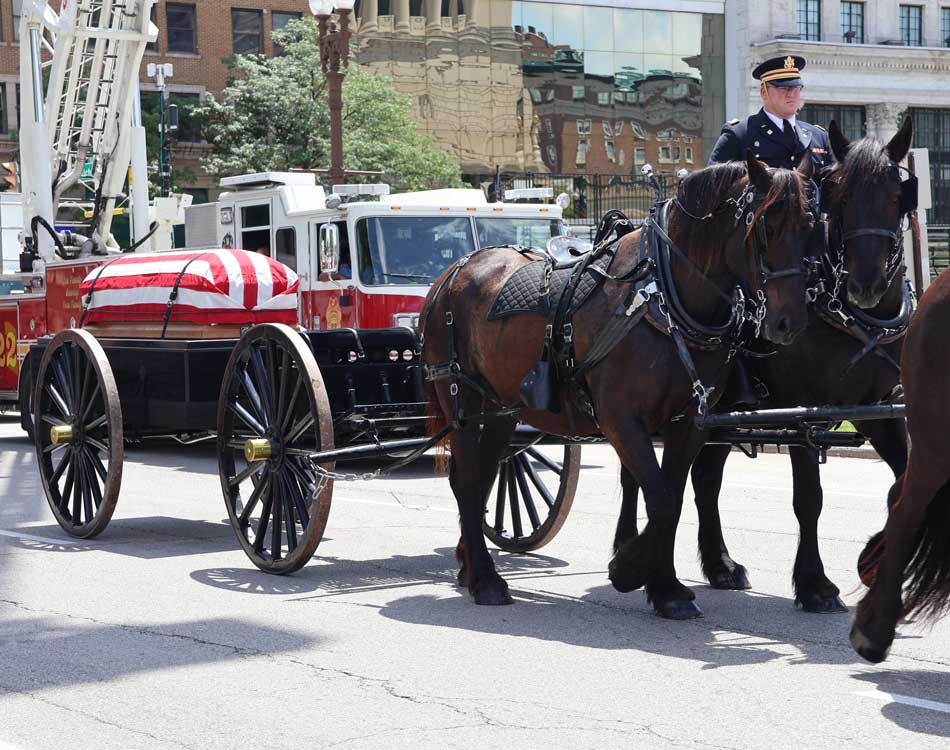
By Cathi Taylor, ALA National Headquarters Archivist
On the Friday before Memorial Day — aka National Poppy Day® — the American Legion Auxiliary’s National Headquarters staff journeys to downtown Indianapolis to hand out poppies and attend The American Legion 500 Festival Memorial Service. While the service changes very little from year to year in its music, speeches, and flyovers, it’s one service I hope never changes — particularly when the caisson is driven by, followed by a horse with the soldier’s boots placed backward in the stirrups.
It is a particularly poignant moment for me as my maternal grandfather served as a wagoner in World War I, guiding a mule-drawn or horse-drawn caisson. He enlisted in the 1st New Hampshire National Guard at 16, serving under Gen. John Pershing in the Mexican Border War. It was nearly one year later that he was heading to France as part of the 103rd infantry’s artillery unit supply company in the Yankee Division.
You might have already guessed that a wagoner’s job was to transport vital supplies such as food, ammunition, medical supplies, as well as troops, to and from the front lines. They were also responsible for the care of their animals — feeding, grooming, and basic veterinary care, along with maintenance of the caissons.
 It was often a dangerous and physically demanding job. Not only did they have to navigate difficult terrain caused by tremendous amounts of rain, but when they were unable to reach the front lines, they were expected to do whatever it took to deliver the much needed supplies — even if it meant crawling through the mud, snow, or rain. And if that wasn’t enough, the wounded and dead were their guest passengers on the return trip.
It was often a dangerous and physically demanding job. Not only did they have to navigate difficult terrain caused by tremendous amounts of rain, but when they were unable to reach the front lines, they were expected to do whatever it took to deliver the much needed supplies — even if it meant crawling through the mud, snow, or rain. And if that wasn’t enough, the wounded and dead were their guest passengers on the return trip.
My grandfather was familiar with injuries and death resulting from farming accidents, but he — like all the other troops — had no experience with those resulting from barbed wire, mortars, grenades, machine guns, cannons, howitzers, flame throwers, or chemical weapons. He may have survived the war, but like so many others, he brought the effects back with him to a country that didn’t know how to deal with these men and women.
My grandparents married about a year or so after his return and they parented eight children in 13 years. I never met the man but learned about him through the children. I must confess that the good times are far outweighed by the bad ones.
 Unfortunately, he became a mean alcoholic, abusing my grandmother and their children. He changed jobs frequently, and the family was evicted from several homes. In my mother’s first 16 years of life, the family moved 21 times. In early 1941, my grandfather took a job to build military bases for England in Trinidad and Tobago. It was the last time the family saw him. It wasn’t until 1960 that he returned to the United States. He passed eight years later.
Unfortunately, he became a mean alcoholic, abusing my grandmother and their children. He changed jobs frequently, and the family was evicted from several homes. In my mother’s first 16 years of life, the family moved 21 times. In early 1941, my grandfather took a job to build military bases for England in Trinidad and Tobago. It was the last time the family saw him. It wasn’t until 1960 that he returned to the United States. He passed eight years later.
Reconstructing my grandfather’s life was not easy for two reasons — his military records were burned in the 1973 fire at the National Personnel Records Center in St. Louis, and my mother didn’t want to know. It was only because he spent his last days at the Miami, Fla., VA hospital that we were able to learn about his time in the military. Mom and I even made a trip to the Andersonville National Cemetery to visit his grave.
While life for the family will never change, my mother and her younger sister — the only remaining children — now understand why their father became the man they knew. He has been forgiven.
Since the Great War, things have somewhat improved for our servicemembers and veterans, but not without the efforts of The American Legion Family. The situation is far from perfect yet as so many are still suffering. But progress is being made. The American Legion Family’s Be the One mission is refocusing the public’s attention to this crisis. The American Legion Auxiliary is a co-presenter, along with the U.S. Department of Veterans Affairs, of the National Veterans Creative Arts Festival. While different in their approaches, these initiatives move the needle toward ending this needless suffering.
It’s difficult to understand Congress’s slow movement in addressing the aftermath of military service for so long. It has been an issue in this country since the American Revolution. How does one deny benefits to a person who was fine at enlistment, but not fine after that enlistment?
Rehabilitation has always been at the heart of veteran service organizations. In an upcoming blog post, we will take a look at the various ways the American Legion Auxiliary has addressed the mental health issues of our military and veterans.
ALA Digital Archive Collection
To learn more about the history of the American Legion Auxiliary, please visit our digital archive collection at https://alaforveterans.pastperfectonline.com.